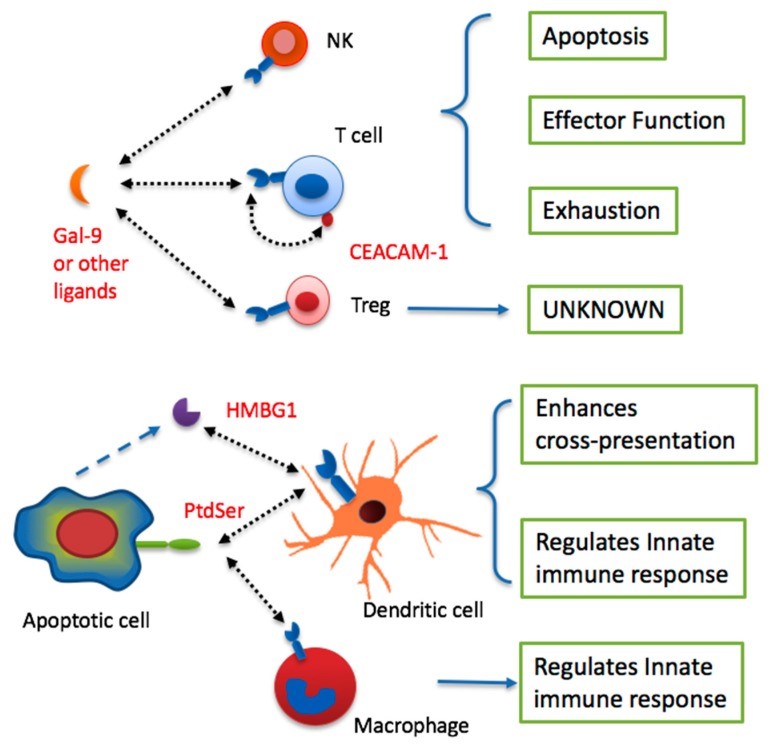Hi-Affi™ hPD-1/hTIGIT/hTIM3 Triple Humanized Mouse Model
TIGIT and TIM3 are newly discovered immunosuppressive molecules on T cells. They have been taken as targets in cancer treatment, together with PD-1. The inhibition of these three different down-regulatory receptors might be a powerful therapy, especially for malignancies. Creative Biolabs has successfully established an optimized Hi-Affi™ “humanized” animal platform to offer specialty manipulated hPD-1/hTIGIT/hTIM3 triple humanized mice for our clients all over the world.
hPD-1/hTIGIT/hTIM3 Molecule
Human programmed cell death protein-1 (hPD-1) is an important immune checkpoint. It has two ligands, human programmed cell death ligand-1(hPD-L1, also called B7-H1, CD274) and human programmed cell death ligand-2 (PD-L2, also called B7-DC, CD273). The interactions of hPD-1 with its ligands inhibit the activation of T cells and the production of cytokines, and play a vital role in maintaining the peripheral tolerance of the body.
Human T cell immunoreceptor TIGIT (hTIGIT) contains Ig and ITIM domains (also known as VSIG9, VSTM3, and WUCAM). It is a member of the immunoglobulin poliovirus receptor family with expression in a subset of T cells and natural killer cells (NKs). In the tumor microenvironment, hTIGIT in tumor-infiltrating lymphocytes is often at a high expression level. hTIGIT can be combined with CD155 (poliovirus receptor (PVR), CD112 (PVRL2, nectin-2), and CD113 (Nectin-3) receptors in immune cells, non-immune cells, and tumor cells. After binding to its ligands, cytotoxicity of T cells and NKs is suppressed.
Human T cell immunoglobulin domain and mucin domain 3 (hTIM3) is called T cell immunoglobulin and mucin domain-containing protein 3. It was first discovered in 2002 and is a member of the human TIM family of immunomodulatory proteins. Because of its relationship with autoimmunity and immune response regulation in cancer, hTIM3 has attracted the most attention. There is an IgV domain at the N-terminus of hTIM3, followed by a mucin domain, a transmembrane domain, and a cytoplasmic tail. Studies have shown that hTIM3 has many different ligands, including galectin-9, phosphatidylserine (PtdSer), CEACAM1, and HMGB1 (high mobility group protein B1).
hPD-1/hTIGIT/hTIM3 Signal Pathway
To ensure that T cells are not overstimulated, there are negative costimulatory molecules that regulate T cells, mainly the hPD-1/hPD-L1 pathway. After the tumor cells invade, they will use this inhibitory pathway to suppress the activation of T cells and escape the encirclement and suppression of the immune system.
hTIGIT can suppress lymphocytes through three different mechanisms of action:1. hTIGIT can signal through the ITIM and/or ITT motif in the tail of its cell after binding to PVR (left in the figure below); 2. hTIGIT can induce PVR signaling in adjacent dendritic cells (DCs) or tumor cells by combining with PVR (middle in the figure below); 3. hTIGIT can inhibit CD226 signaling by binding PVR with higher affinity or disrupting CD226 homodimerization (right in the figure below).
Studies found that the ligand galectin-9 of hTIM3 is abundantly expressed in the tumor microenvironment, and hTIM3 can inhibit the activity of Th1 cells by binding to galectin-9. Therefore, by inhibiting the binding of hTIM3 and its ligand, anti-TIM3 antibody can release the inhibition of Th1 cell activity, prevent its negative regulation of the immune system, and achieve the purpose of treating tumors. Although the hTIM3-CEACAM1 axis is considered to be an important target for cancer immunotherapy, the interaction between the two in the tumor microenvironment is highly complex (e.g., the study found that in a chemically induced colorectal cancer model, CEACAM1-/-mice produced a higher tumor burden, indicating that CEACAM1 may have a tumor suppressor function; another study found that CEACAM1 can be highly expressed by melanoma cells and play a role in suppressing T cell responses ). Thus, its regulatory mechanism needs further study.
 Fig.1 Multiple functions of TIGIT. (Du, 2017)1, 2
Fig.1 Multiple functions of TIGIT. (Du, 2017)1, 2
Development of hPD-1/hTIGIT/hTIM3 Triple Humanized Mice
New data from human clinical trials indicates that in terms of function, hTIM3 and hTIGIT are indeed "checkpoint" receptors, and inhibition of hTIM3 and hTIGIT can enhance the anti-tumor effect of hPD-1 blockade. These results bring new hope to cancer patients who cannot benefit from anti-hPD-1 antibodies alone. Creative Biolabs has years of experience in CRO service and has assisted our global clients in lots of study projects using our Hi-Affi™ “humanized” animal models. If you are interested in these humanized mice, please feel free to contact us for more details.
Creative Biolabs also offers other various Humanized Mouse Models you may be interested in:
References
- Du, W.; et al. TIM-3 as a target for cancer immunotherapy and mechanisms of action. Int J Mol Sci. 2017, 18(3).
- under Open Access license CC BY 4.0, without modification.
For Research Use Only.
